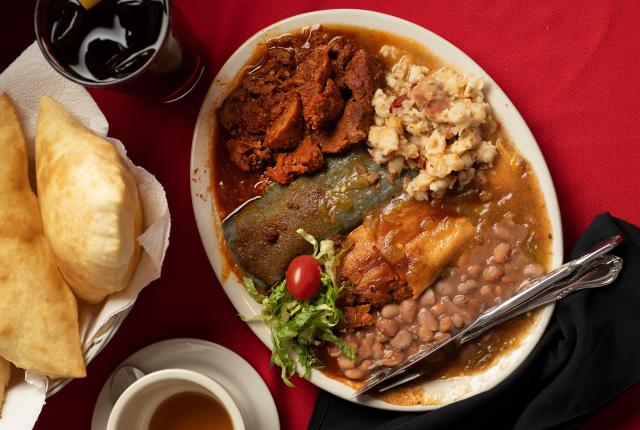DINING AT THE LEGENDARY Rancho de Chimayó feels like coming home. Perhaps that’s because this hacienda in historic Chimayó was the family residence of Arturo Jaramillo, who grew up here savoring traditional New Mexican cooking. In 1965, he and his wife, Florence—known to everyone as “Mrs. J”—opened their charming restaurant, serving many of those recipes, in this adobe.
Chile ristras hang outside as a familiar greeting. Family portraits and Chimayó weavings adorn the walls, while aromas of red and green chile perfume the dining rooms. All of it stacks the anticipation like tortillas on a platter for the first bite of the house specialty, carne adovada, made with pork marinated to tender perfection in earthy, sweet red chile famously grown not far from these doors.
“It’s a hard business lately,” says Mrs. J, who, at 92, knows what it takes to run a New Mexico classic. “But you can make a lot of people happy, and that’s what’s important. You treat them with kindness.” Consistency counts, too. “People are happy when they come back and nothing’s changed,” she adds.
Whether it’s a centuries-old hacienda, a café inspired by an old-school soda fountain, or a kitsch-covered diner, New Mexico’s landmark restaurants share many of the same ingredients: family recipes inspired by Native and early Spanish traditions and made with time-honored techniques; kitchens and dining rooms staffed with grandmas, aunties, fathers, sons, daughters, and grandkids; longtime employees who might as well be related; a connection with community; and a passion for the work. “We cook with love,” says Janice Baca Argabright, the third-generation owner of the Owl Bar & Café in San Antonio. “I consider my employees one big family, and they think of me as family also.”
While the food is often simple, the flavors are complex—rooted in the land, layered by history, and seasoned with hospitality. What started with corn, beans, and squash grown by Pueblo people evolved into traditional New Mexican cuisine after the 16th-century arrival of the Spanish, who brought fruit, livestock, and other ingredients. Newcomers to the state have since stirred their own ingredients into the pot, resulting in a rich stew of flavors and influences. The chuck wagons and Dutch ovens, for instance, that kept cowboys and ranchers fed on biscuits and beans paved the way for ranch-hand steak houses, later followed by Route 66 diners along the “Mother Road,” introducing touring Americans to our famed green chile cheeseburger.
But it hasn’t always been an easy road. These classics have survived depressions, droughts, pandemics, and changing culinary tastes. “It takes hard work,” says Olga Garcia, co-owner and chef of El Paragua, the Española restaurant opened by her parents in 1966. “It also takes a lot of blessings. Our parents had a great faith. We continue that today.”
Read more: How New Mexico became the undisputed champion of the green chile cheeseburger.



